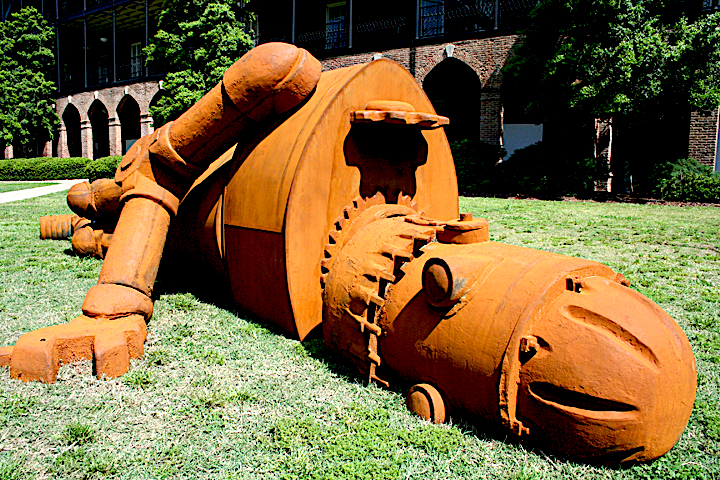 EMERGING TECH
EMERGING TECH
 EMERGING TECH
EMERGING TECH
 EMERGING TECH
EMERGING TECH
As any science fiction fan knows, it’s always a bad sign when a robot has dreams or visions of its own. Think Isaac Asimov’s short story collection “Robot Dreams,” Alex Proyas’ 2006 dystopian whodunit “I, Robot” or Kike Maíllo’s 2011 thriller “Eva.“
But for artificial intelligence researchers, the whole notion is anything but a nightmare scenario. In fact, dreaming may be the key to creating AI systems, agents and robots that learn faster and more deeply — that is, more like humans do.
“What we’re trying to do is incorporate sleep and dreamlike processes into the cognitive architecture of machines,” says Natalia Díaz Rodríguez, a researcher for the Paris-based research initiative, Project DREAM, which stands for Deferred Restructuring of Experiences in Autonomous Machines.
A spate of recent studies suggests that sleep and dreaming process helps the human brain sort through all the day’s experiences to consolidate and more deeply embed the most important ones. Similarly, by giving robots and AI systems off periods where they can review and consolidate what humans have taught them, Project DREAM “might also allow these robots to come up with new information and to learn and adapt to changing events,” she said.

Project DREAM researcher Natalia Díaz Rodríguez (Photo: GitHub)
“What we are doing is focusing on unsupervised, deep reinforcement learning for robots,” she added. “The aim is to teach them with the minimal human supervision so they can reuse, with cognitive architectures, the knowledge they need to learn and do further tasks.”
ProjectDREAM, which is funded by a Horizon 2020 European Union research grant, spans a number of major European institutions, including coordinator Université Pierre et Marie Curie, CNRS, ENSTA ParisTech, VU Amsterdam, University of Edinburgh and the Universidade da Coruña. It’s testing its ideas in deep learning — a form of artificial neural network that allows computers to learn on their own instead of being explicitly programmed, leading to recent breakthroughs in speech and image recognition — with multiple manufacturers’ robots, including CrustCrawler’s articulated robotic arm and Rethink Robotics’ humanoid robot, Baxter.
The goal, they say, is to come up with a system that allows any robot to sift through what it has learned during the day and reorganize it during during the robot’s equivalent of sleep. As a result, they might begin to interact better with their environments on their own.
Before they dream, ProjectDream’s robots must first learn how to learn via reinforcement techniques — that is, through a series of rewards and penalties. The more things it has “learned” about, the more material Baxter will have to process off-time later in unstructured learning sessions. Here’s one example of how Project DREAM researchers have used deferred unstructured learning techniques and reinforcement rules to help Baxter the Robot figure out how to play ball:
ProjectDream is one of several AI and deep learning initiatives aiming to blend reinforcement-based unstructured learning and predefined “off times” akin to sleep and dreaming, when robots can review and retrace what they’ve learned.
There is, for example, the RobDREAM project. Based in Augsburg, Germany, the effort purports to give robots “the power to dream.” That is, the aim is to build industrial robots that, during so-called idle times, will sift through the data and lessons they learned by day.
“The dreaming aspect itself is that we want to use all this collected data in a simulation environment, where we can simulate the behavior of the algorithms used in the robots’ systems overnight,” project coordinator Daniel Braun said via EU Horizon 2020, which funds the effort. It is, he said, “basically the same as dreaming in humans – you make some experiences during the day … and overnight it’s somehow processed in simulation.”
Google LLC’s DeepMind is thinking about sleeping and dreaming robots, too. That came to light last fall, when Google DeepMind researchers said they had developed an AI agent called UNREAL. Short for Unsupervised Reinforcement and Auxiliary Learning, the UNREAL agent was able to learn how to play the 3D maze game “The Labyrinth” 10 times faster, achieving about 87 percent of “expert human” performance at the challenge, and about nine times “typical human performance” across a number of Atari titles, they said.
The researchers credited reinforcement techniques and other unsupervised, unstructured learning tasks with aiding the progress. Such techniques, they said, can “simulate how animals dream, an unstructured time of learning where it can review human inputs just as animals dream about positively or negatively rewarding events more frequently, our agents preferentially replay sequences containing rewarding events.”
Like the ProjectDream and RobDream efforts in Europe, Google researchers aim to build deep learning programs that “can learn to solve any complex problem without needing to be taught how.” Here’s a look at how the techniques work:
To date, advances such as speech and image recognition ushered in by deep learning and related machine learning techniques have made it seem as if we’re on the cusp of thinking machines. In reality, they’re still far away from that goal, requiring much more data and power than the human brain while still not coming close to matching the brain’s processing abilities. Incorporating the equivalent of dreaming into the algorithms may get machines a step closer by giving hem some of the same benefits humans get from a good night’s sleep.
Gina Smith, Ph.D., is an award-winning tech journalist and the New York Times bestselling author of Steve Wozniak’s biography, “iWOZ: How I Invented the Personal Computer and Had Fun Doing It” (2006/2014, W.W. Norton) and “The Genomics Age: Why DNA Technology Changes Everything” (2005/2011, Amacom), a Barron’s Book of the Year. Follow Gina on Twitter @ginasmith888.
Support our mission to keep content open and free by engaging with theCUBE community. Join theCUBE’s Alumni Trust Network, where technology leaders connect, share intelligence and create opportunities.
Founded by tech visionaries John Furrier and Dave Vellante, SiliconANGLE Media has built a dynamic ecosystem of industry-leading digital media brands that reach 15+ million elite tech professionals. Our new proprietary theCUBE AI Video Cloud is breaking ground in audience interaction, leveraging theCUBEai.com neural network to help technology companies make data-driven decisions and stay at the forefront of industry conversations.